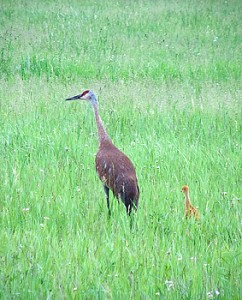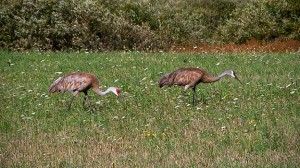Michigan’s tallest breeding bird is the Sandhill Crane. Cranes and Great Blue Herons are often confused by beginning birders. Adult Sandhills are gray overall, with a white auricular region (the bird’s facial “cheeks”) and a red cap. The red cap is an area missing feathers so the adults have a bald spot. Young birds lack the white cheeks and red cap being brown overall. Cranes never show the bluish cast of the heron. Sandhill Cranes often fly in a v-formation. Their quick wing upbeat distinguishes them, even at a great distance, from other birds. Closer, one can see their outstretched necks. Herons hold their necks in an “s” shape while flying.
The Michigan subspecies is the Greater Sandhill Crane (Grus canadensis subsp. tabida). The genus is Grus, the specific name is canadensis, and the subspecies is tabida (for Mr. Olsen’s class). Greater Sandhill Cranes are five feet tall and weigh approximately fourteen pounds.
Birds return to southern Michigan in February and start nesting in March. A normal clutch is two eggs but most pairs successfully raise only one offspring a year. The young can fly in about 70 days. They spend the first year with their parents. It takes five to seven years for the young to reach maturity. Captive birds live as long as 60 years.
Barrows’ prediction in 1912 that the species would abandon Michigan never came true. He writes that the population was stressed because “The Sandhill Crane has been a favorite mark for the rifle, its flesh forms palatable food, and its nesting grounds have been lessened through drainage” (Barrows 12). The federal government protected the Sandhill Crane in 1916. In the 1930s and 40s it nested in just 12 counties. By the 1980s, it bred in 44 counties. The population increased two or three times from the first Breeding Bird Atlas of Michigan (1991) to the second (2011) and it now occurs in every county in the state (Hoffman). With the population increase, more states are considering allowing the hunting of this regal bird. Currently thirteen states have an established hunting season.
It was a red-letter day to see this bird when I was growing up, but now on most trips (during the growing season) to our Grayling cabin we see at least a pair of them. It is still exciting to see a migrating flock of these magnificent birds. I hope that the crane’s population will be maintained for future generations.
Works cited
Barrows, W.B. 1912. Michigan Bird Life. Special Bulletin. Michigan Agricultural College. Lansing, Michigan, USA.
Hoffman, R. 2011. Sandhill Crane (Grus canadensis). In A.T. Chartier, J.J. Baldy, and J.M. Brenneman, editors. The Second Michigan Breeding Bird Atlas. Kalamazoo Nature Center. Kalamazoo, Michigan, USA. Accessed online at: <www.mibirdatlas.org /Portals/12/MBA2010/SACRaccount.pdf >.



